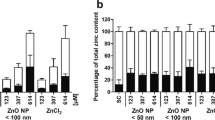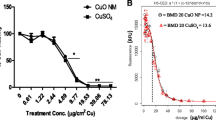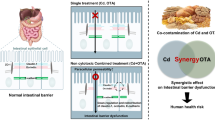Abstract
Copper might be toxic to human intestinal cells because of its ability to catalyze the formation of free radicals. The aim of the present study was to quantify toxicological effects of increasing copper concentrations in preconfluent, colonic cancerous cells as well as in postconfluent, differentiating Caco-2 cells. Our results indicate that postconfluent cells might be more sensitive to copper toxicity. A significant rise of lactate dehydrogenase (LDH) release (150 µM or above) and decrease of cell proliferation (100 µM or above) with increasing copper levels was found, as compared to the control. To the contrary, preconfluent cells were not significantly affected by copper (LDH release) or, if so, only at a concentration of 250 µM (proliferation). Loss of viability and morphological changes, including loss of adherence and cell rounding, were visible after incubation with 250 µM copper in both groups. Superoxide dismutase (SOD) activities were not affected by copper. Glutathione peroxidase (GSH-Px) and catalase activities were higher in copper-treated cells, especially in the postconfluent ones (nevertheless, the results were not significant because of high standard deviations). In conclusion, we demonstrated that copper exerts intracellular, toxicological effects on both groups of Caco-2 cells, although the effects seem to be more evident in the postconfluent (enterocytelike) group. Risk assessment, especially for high concentrations, might be of special interest.
Similar content being viewed by others
References
National Academy of Science (NAS) Subcommittee on the Tenth Edition of the RDAs, Food and Nutrition Board Commission on Life Sciences, National Research Council, Recommended Dietary Allowances, 10th ed., National Academy Press, Washington, DC (1989).
X. D. Thanh, S. Djebbar-Sid, O. Benali-Baitich, et al., Stability, toxicity and cytotoxicity of a cupric complex towards cultured Caco-2 cells, Anticancer Res. 20, 4639–4642 (2000).
O. I. Aruoma and B. Halliwell, Free Radicals and Food Additives, Taylor & Francis, London (1991).
B. Halliwell and S. Chirico, Lipid peroxidation: its mechanism, measurement, and significance, Am. J. Clin. Nutr. 57, 715S–725S (1993).
J. M. Mates and F. Sanchez-Jimenez, Antioxidant enzymes and their implications in pathophysiologic processes, Front. Biosci. 4, 339–345 (1999).
G. Vendemiale, I. Grattagliano, and E. Altomare, An update on the role of free radicals and antioxidant defense in human disease, Int. J. Clin. Lab. Res. 29, 49–55 (1999).
M. Romeo, N. Bennani, M. Gnassia-Barelli, et al., Cadmium and copper display different responses towards oxidative stress in the kidney of the sea bass Dicentrarchus labrax, Aquat. Toxicol. 48, 185–194 (2000).
N. S. Aston, N. Watt, I. E. Morton, et al., Copper toxicity affects proliferation and viability of human hepatoma cells (HepG2 Line), Hum. Exp. Toxicol. 19, 367–376 (2000).
M. B. Grisham, C. von Ritter, B. F. Smith, et al., Interaction between oxygen radicals and gastric mucin, Am. J. Physiol. 253, G93-G96 (1987).
C. F. Babbs, Free radicals and the etiology of colon cancer, Free Radical Biol. Med. 8, 191–200 (1990).
M. L. Scarino, R. Poverini, G. Di Lullo, et al., Inhibition of protein synthesis after exposure of Caco-2 cells to heavy metals, ATLA 20, 325–333 (1992).
C. Ekmekcioglu, G. Strauss-Blasche, V. J. Leibetseder, et al., Toxicological and biochemical effects of different beverages on human intestinal cells, Food Res. Int. 32, 421–427 (1999).
P. J. Guzzie, Lethality testing, in In Vitro Toxicology, S. C. Gad, ed., Raven, New York, pp. 57–86 (1994).
H. Aebi, Catalase in vitro, Methods Enzymol. 105, 121–126 (1984).
J. M. Gotz, C. I. van Kan, H. W. Verspaget, et al., Gastric mucosal superoxide dismutases in Helicobacter pylori infection, Gut 38(4), 502–506 (1996).
L. Flohe and W. A. Gunzler, Assays of glutathione peroxidase, Methods Enzymol. 105, 114–121 (1984).
T. Noda, R. Iwakiri, K. Fujimoto, et al., Induction of mild intracellular redox imbalance inhibits proliferation of Caco-2 cells, FASEB J. 15(12), 2131–2139 (2001).
E. Cario, S. Jung, J. Harder d’Heureuse, et al., Effects of exogenous zinc supplementation on intestinal epithelial repair in vitro, Eur. J. Clin. Invest. 30, 419–428 (2000).
P. G. Reeves, M. Briske-Anderson, and S. M. Newman, Jr., High zinc concentrations in culture media effect copper uptake and transport in differentiated human colon adenocarcinoma cells, J. Nutr. 126, 1701–1712 (1996).
S. Ferruzza, Y. Sambuy, M. R. Ciriolo, et al., Copper uptake and intracellular distribution in the human intestinal Caco-2 cell line, Biometals 13, 179–185 (2000).
D. J. Howard, R. B. Ota, L. A. Briggs, et al., Oxidative stress induced by environmental tobacco smoke in the workplace is mitigated by antioxidant supplementation, Cancer Epidemiol. Biomarkers Prev. 7, 981–988 (1998).
S. S. Baker and R. D. Baker, Antioxidant enzymes in the differentiated Caco-2 cell line, In Vitro Cell. Dev. Biol. 28A, 643–647 (1992).
F. Y. Leung, Trace elemets that act as antioxidants in parenteral micronutrition, J. Nutr. Biochem. 9, 304–307 (1998).
R. D. Raffaniello and R. A. Wapnir, Zinc-induced metallothionein synthesis by Caco-2 cells, Biochem. Med. Metab. Biol. 45, 101–107 (1991).
F. Vecchini, E. Pringault, T. R. Billiar, et al., Decreased activity of inducibel nitric oxide synthase type 2 and modulation of the expression of glutathione S-transferase alpha, bcl-2, and metallothioneins during differentiation of CaCo-2 cells, Cell Growth Differ. 8, 261–268 (1997).
Q. Ding, Q. Wang, and B. M. Evers, Alteration of MAPK activities associated with intestinal cell differentiation, Biochem. Biophys. Res. Commun. 284, 282–288 (2001).
R. Gauthier, C. Harnois, J. F. Drolet, et al., Human intestinal epithelial cell survival: differentiation state-specific control mechanisms, Am. J. Physiol. (Cell Physiol.) 280, C1540–C1554 (2001).
Author information
Authors and Affiliations
Rights and permissions
About this article
Cite this article
Zödl, B., Zeiner, M., Marktl, W. et al. Pharmacological levels of copper exert toxic effects in Caco-2 cells. Biol Trace Elem Res 96, 143–152 (2003). https://doi.org/10.1385/BTER:96:1-3:143
Received:
Revised:
Accepted:
Issue Date:
DOI: https://doi.org/10.1385/BTER:96:1-3:143




